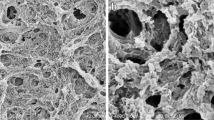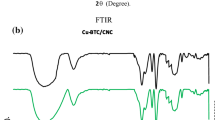Abstract
In the present study, the cellulose/zinc oxide hybrid aerogel (CA/ZnO) was successfully synthesized via different as-prepared methods. The obtained ZnO structure in CA/ZnO hybrid aerogel indicated porous hemispherical structures, cone-like, nanorod (rice grain-like shape), and flower-like morphologies. The different created structure for the as-prepared samples may be due to the different growth of zinc oxide under synthesis conditions.The as-synthesized samples were determined by X-ray diffraction (XRD), Fourier transforms infrared (FT-IR), field emission scanning electron microscopy (FE-SEM), Energy dispersive X-ray analysis (EDX), Brunauer–Emmett–Teller (BET), UV-Vis spectroscopy. Then, their effect on the removal efficiency of methyl orange (MO) solution was investigated under UV light irradiation. The BET analysis revealed that specific surface area of the as-prepared samples with using different methods was in the range of 43.70–352.82 m2/g. The obtained results indicated that the morphology of CA/ZnO hybrid aerogel plays a significant role in the photodegradation performance of MO. Among all as-prepared samples with different morphologies, the plate-like structure of ZnO demonstrated the maximum removal efficiency of MO (94.78%).
Graphic Abstract












Similar content being viewed by others
References
Singh N, Nagpal G, Agrawal S (2018) Water purification by using adsorbents: a review. Environ Technol Innov 11:187–240
Zhao W et al (2018) Comparative study of modified/non-modified aluminum and silica aerogels for anionic dye adsorption performance. RSC Adv 8(51):29129–29140
Correia T et al (2020) Manual treatment of urban wastewater by chemical precipitation for production of hydroponic nutrient solutions. J Ecol Eng 21(3):143
Kong L, Liu X (2020) Emerging electrochemical processes for materials recovery from wastewater: mechanisms and prospects. Front Environ Sci Eng 14(5):1–14
Zhang, H. and Y. Mingchuan, Method of water purification using hydrophilic and compressible aerogel as draw agent in forward osmosis. 2020, Google Patents.
Zhou Z et al (2014) Polyaniline-decorated cellulose aerogel nanocomposite with strong interfacial adhesion and enhanced photocatalytic activity. RSC Adv 4(18):8966–8972
Shen D et al (2018) Green synthesis of Fe 3 O 4/cellulose/polyvinyl alcohol hybride aerogel and its application for dye removal. J Polym Environ 26(6):2234–2242
Ferreira-Neto EP et al (2020) Bacterial nanocellulose/MoS2 hybrid aerogels as bifunctional adsorbent/photocatalyst membranes for in-flow water decontamination. ACS Appl Mater Interfaces 12(37):41627–41643
Bai W et al (2020) Robust and recyclable macroscopic g-C3N4/cellulose hybrid photocatalysts with enhanced visible light photocatalytic activity. Appl Surf Sci 504:144179
Xiaolin D et al (2019) High photocatalytic activity of Cu@ Cu2O/RGO/cellulose hybrid aerogels as reusable catalysts with enhanced mass and electron transfer. React Funct Polym 138:79–87
Yang L et al (2020) Development of eco-friendly CO2-responsive cellulose nanofibril aerogels as “green” adsorbents for anionic dyes removal. J Hazard Mater. https://doi.org/10.1016/j.jhazmat.2020.124194
Saeed RMY et al (2019) CuS-functionalized cellulose based aerogel as biocatalyst for removal of organic dye. J Appl Polym Sci 136(15):47404
Ren W et al (2018) Recyclable metal-organic framework/cellulose aerogels for activating peroxymonosulfate to degrade organic pollutants. Chem Eng J 349:766–774
Wu Y et al (2020) Zeolitic imidazolate Framework-67@ Cellulose aerogel for rapid and efficient degradation of organic pollutants. J Solid State Chem 291:121621
Chen Y et al (2020) Effective photocatalytic degradation and physical adsorption of methylene blue using cellulose/GO/TiO 2 hydrogels. RSC Adv 10(40):23936–23943
Yang X et al (2018) Cellulose acetate-based SiO2/TiO2 hybrid microsphere composite aerogel films for water-in-oil emulsion separation. Appl Surf Sci 435:609–616
Li H et al (2020) Macro-/nanoporous Al-doped ZnO/cellulose composites based on tunable cellulose fiber sizes for enhancing photocatalytic properties. Carbohydr Polym 250:116873
Li X et al (2018) Facile synthesis of cellulose/ZnO aerogel with uniform and tunable nanoparticles based on ionic liquid and polyhydric alcohol. ACS Sustain Chem Eng 6(12):16248–16254
Wang Q et al (2017) Facile construction of cellulose nanocomposite aerogel containing TiO2 nanoparticles with high content and small size and their applications. Cellulose 24(5):2229–2240
Li M et al (2020) Cellulose/TiO2-based carbonaceous composite film and aerogel for highly efficient photocatalysis under visible light. Ind Eng Chem Res 59(31):13997–14003
Wan C et al (2015) A facile low-temperature hydrothermal method to prepare anatase titania/cellulose aerogels with strong photocatalytic activities for rhodamine B and methyl orange degradations. J Nanomater. https://doi.org/10.1155/2015/717016
Feng J et al (2016) Silica cellulose hybrid aerogels for thermal and acoustic insulation applications. Colloids Surf A 506:298–305
Wan C et al (2016) Preparation, characterization, and antibacterial properties of silver nanoparticles embedded into cellulose aerogels. Polym Compos 37(4):1137–1142
Hosseini H et al (2020) Lightweight aerogels based on bacterial cellulose/silver nanoparticles/polyaniline with tuning morphology of polyaniline and application in soft tissue engineering. Int J Biol Macromol 152:57–67
Majumder S et al (2020) ZnO based nanomaterials for photocatalytic degradation of aqueous pharmaceutical waste solutions—a contemporary review. Environ Nanotechnol Monit Manag. https://doi.org/10.1016/j.enmm.2020.100386
Sharma, D.K., et al., A review on ZnO: Fundamental properties and applications. Materials Today: Proceedings, 2020.
Weldegebrieal GK (2020) Synthesis method, antibacterial and photocatalytic activity of ZnO nanoparticles for azo dyes in wastewater treatment: a review. Inorg Chem Commun 120:108140
Geng H (2018) Preparation and characterization of cellulose/N, N’-methylene bisacrylamide/graphene oxide hybrid hydrogels and aerogels. Carbohyd Polym 196:289–298
Miao Y et al (2020) A facile method for in situ fabrication of silica/cellulose aerogels and their application in CO2 capture. Carbohydr Polym. https://doi.org/10.1016/j.carbpol.2020.116079
Jiao Y et al (2018) Facile hydrothermal synthesis of Fe3O4@ cellulose aerogel nanocomposite and its application in fenton-like degradation of rhodamine B. Carbohyd Polym 189:371–378
Chong KY et al (2015) CaCO 3-decorated cellulose aerogel for removal of congo red from aqueous solution. Cellulose 22(4):2683–2691
Ma X et al (2019) Multifunctional flexible composite aerogels constructed through in-situ growth of metal-organic framework nanoparticles on bacterial cellulose. Chem Eng J 356:227–235
Chen S et al (2013) Polyol mediated synthesis of ZnO nanoparticles templated by bacterial cellulose. Carbohydr Polym 92(2):1953–1959
Shi J et al (2013) Heat insulation performance, mechanics and hydrophobic modification of cellulose–SiO2 composite aerogels. Carbohydr Polym 98(1):282–289
Jiao Y, Wan C, Li J (2015) Room-temperature embedment of anatase titania nanoparticles into porous cellulose aerogels. Appl Phys A 120(1):341–347
Cui S et al (2018) Preparation of magnetic MnFe 2 O 4-cellulose aerogel composite and its kinetics and thermodynamics of Cu (II) adsorption. Cellulose 25(1):735–751
Shimpi N et al (2020) Synthesis of rod-like ZnO nanostructure: study of its physical properties and visible-light driven photocatalytic activity. Optik 217:164916
Li T et al (2013) Controllable growth of ZnO mesocrystals using a facile electrochemical approach. Chem Phys Lett 555:154–158
Ganesh RS et al (2018) ZnO hierarchical 3D-flower like architectures and their gas sensing properties at room temperature. Appl Surf Sci 449:314–321
Rokesh K et al (2016) A facile solid state synthesis of cone-like ZnO microstructure an efficient solar-light driven photocatalyst for rhodamine B degradation. Mater Today Proc 3(10):4163–4172
Lu Y et al (2011) A comparative study on plate-like and flower-like ZnO nanocrystals surface photovoltage property and photocatalytic activity. Mater Chem Phys 129(1–2):281–287
Pung S-Y, Lee W-P, Aziz A (2012) Kinetic study of organic dye degradation using ZnO particles with different morphologies as a photocatalyst. Int J Inorg Chem. https://doi.org/10.1155/2012/608183
Pardeshi S, Patil A (2009) Effect of morphology and crystallite size on solar photocatalytic activity of zinc oxide synthesized by solution free mechanochemical method. J Mol Catal A Chem 308(1–2):32–40
Sahu K et al (2018) Facile synthesis of ZnO nanoplates and nanoparticle aggregates for highly efficient photocatalytic degradation of organic dyes. J Phys Chem Solids 121:186–195
Bustos-Torres KA et al (2017) Influence of the morphology of ZnO nanomaterials on photooxidation of polypropylene/ZnO composites. Mater Sci Semicond Process 68:217–225
Fakhri H, Mahjoub A, Khavar AC (2014) Synthesis and characterization of ZnO/CuInS2 nanocomposite and investigation of their photocatalytic properties under visible light irradiation. Appl Surf Sci 318:65–73
Kajbafvala A et al (2012) Effects of morphology on photocatalytic performance of zinc oxide nanostructures synthesized by rapid microwave irradiation methods. Superlattices Microstruct 51(4):512–522
Akir S et al (2016) Eco-friendly synthesis of ZnO nanoparticles with different morphologies and their visible light photocatalytic performance for the degradation of rhodamine B. Ceram Int 42(8):10259–10265
Gupta R et al (2017) Effect of morphology of zinc oxide in ZnO-CdS-Ag ternary nanocomposite towards photocatalytic inactivation of E. coli under UV and visible light. Chem Eng J 307:966–980
Flores NM et al (2014) Effects of morphology, surface area, and defect content on the photocatalytic dye degradation performance of ZnO nanostructures. RSC Adv 4(77):41099–41110
Hasanpour M et al (2021) Investigation of operation parameters on the removal efficiency of methyl orange pollutant by cellulose/zinc oxide hybrid aerogel. Chemosphere. https://doi.org/10.1016/j.chemosphere.2021.131320
Hasanpour M et al (2021) Numerical modeling for the photocatalytic degradation of methyl orange from aqueous solution using cellulose/zinc oxide hybrid aerogel: comparison with experimental data. Top Catal. https://doi.org/10.1007/s11244-021-01451-y
Zhao Y et al (2020) Preparation and oil adsorption properties of hydrophobic microcrystalline cellulose aerogel. Cellulose 27(13):7663–7675
Murali S et al (2020) Polyol mediated synthesis of anisotropic ZnO nanomaterials and composite with rGO: application towards hybrid supercapacitor. J Alloys Compd 844:156149
Guan Y et al (2019) Green one-step synthesis of ZnO/cellulose nanocrystal hybrids with modulated morphologies and superfast absorption of cationic dyes. Int J Biol Macromol 132:51–62
Lefatshe K, Muiva CM, Kebaabetswe LP (2017) Extraction of nanocellulose and in-situ casting of ZnO/cellulose nanocomposite with enhanced photocatalytic and antibacterial activity. Carbohydr Polym 164:301–308
Sun Y et al (2016) The applications of morphology controlled ZnO in catalysis. Catalysts 6(12):188
Yi Z et al (2011) Photocatalytic activity and stability of ZnO particles with different morphologies. Rare Met 30(1):183–187
Author information
Authors and Affiliations
Corresponding author
Additional information
Publisher's Note
Springer Nature remains neutral with regard to jurisdictional claims in published maps and institutional affiliations.
Rights and permissions
About this article
Cite this article
Hasanpour, M., Motahari, S., Jing, D. et al. Investigation of the Different Morphologies of Zinc Oxide (ZnO) in Cellulose/ZnO Hybrid Aerogel on the Photocatalytic Degradation Efficiency of Methyl Orange. Top Catal (2021). https://doi.org/10.1007/s11244-021-01476-3
Accepted:
Published:
DOI: https://doi.org/10.1007/s11244-021-01476-3




